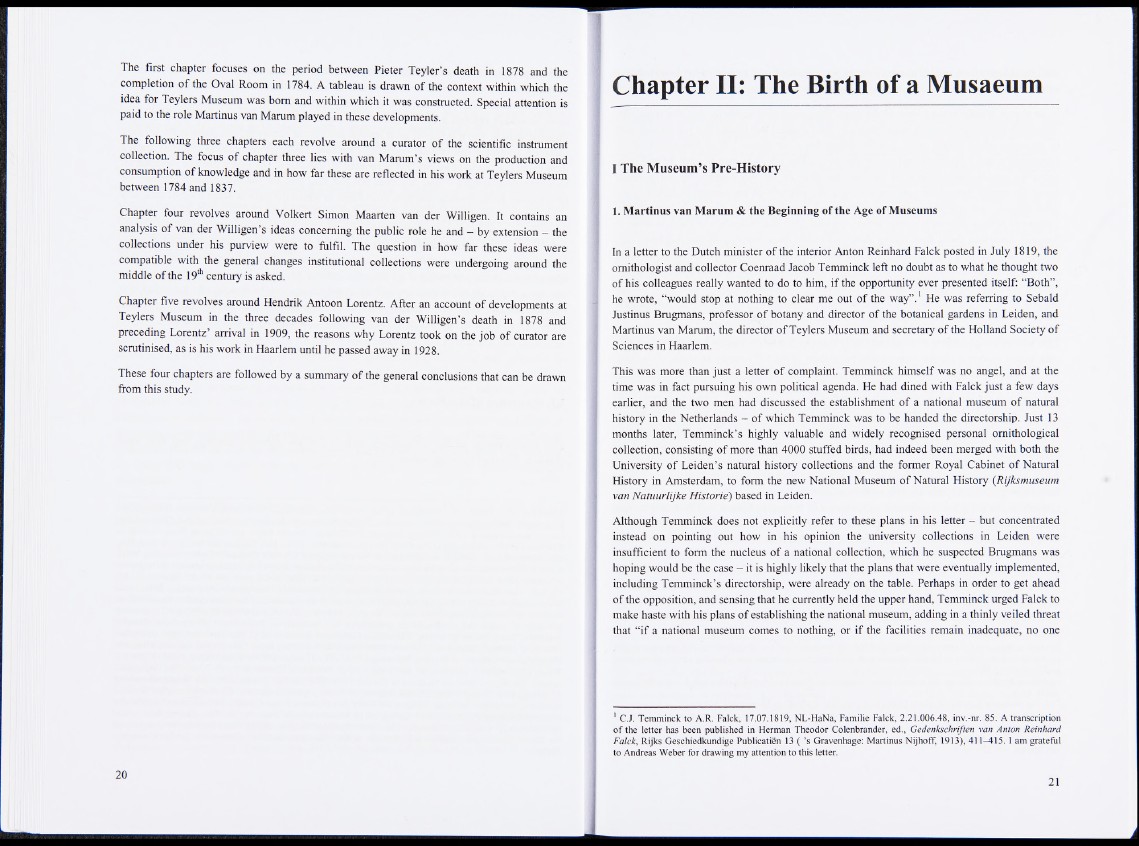
The first chapter focuses on the period between Pieter Teyler’s death in 1878 and the
completion of the Oval Room in 1784. A tableau is drawn of the context within which the
idea for Teylers Museum was bom and within which it was constructed. Special attention is
paid to the role Martinus van Marum played in these developments.
The following three chapters each revolve around a curator of the scientific instrument
collection. The focus of chapter three lies with van Marum’s views on the production and
consumption of knowledge and in how far these are reflected in his work at Teylers Museum
between 1784 and 1837.
Chapter four revolves around Volkert Simon Maarten van der Willigen. It contains an
analysis of van der Willigen’s ideas concerning the public role he and - by extension - the
collections under his purview were to fulfil. The question in how far these ideas were
compatible with the general changes institutional collections were undergoing around the
middle of the 19th century is asked.
Chapter five revolves around Hendrik Antoon Lorentz. After an account of developments at
Teylers Museum in the three decades following van der Willigen’s death in 1878 and
preceding Lorentz arrival in 1909, the reasons why Lorentz took on the job of curator are
scrutinised, as is his work in Haarlem until he passed away in 1928.
These four chapters are followed by a summary of the general conclusions that can be drawn
from this study.
Chapter II: The Birth of a Musaeum
I The Museum’s Pre-History
1. Martinus van Marum & the Beginning of the Age of Museums
In a letter to the Dutch minister of the interior Anton Reinhard Falck posted in July 1819, the
ornithologist and collector Coenraad Jacob Temminck left no doubt as to what he thought two
of his colleagues really wanted to do to him, if the opportunity ever presented itself: “Both”,
he wrote, “would stop at nothing to clear me out of the way”.1 He was referring to Sebald
Justinus Brugmans, professor of botany and director of the botanical gardens in Leiden, and
Martinus van Marum, the director of Teylers Museum and secretary of the Holland Society of
Sciences in Haarlem.
This was more than just a letter of complaint. Temminck himself was no angel, and at the
time was in fact pursuing his own political agenda. He had dined with Falck just a few days
earlier, and the two men had discussed the establishment of a national museum of natural
history in the Netherlands - of which Temminck was to be handed the directorship. Just 13
months later, Temminck’s highly valuable and widely recognised personal ornithological
collection, consisting of more than 4000 stuffed birds, had indeed been merged with both the
University of Leiden’s natural history collections and the former Royal Cabinet of Natural
History in Amsterdam, to form the new National Museum of Natural History (Rijksmuseum
van Natuurlijke Historie) based in Leiden.
Although Temminck does not explicitly refer to these plans in his letter - but concentrated
instead on pointing out how in his opinion the university collections in Leiden were
insufficient to form the nucleus of a national collection, which he suspected Brugmans was
hoping would be the case - it is highly likely that the plans that were eventually implemented,
including Temminck’s directorship, were already on the table. Perhaps in order to get ahead
of the opposition, and sensing that he currently held the upper hand, Temminck urged Falck to
make haste with his plans of establishing the national museum, adding in a thinly veiled threat
that “if a national museum comes to nothing, or if the facilities remain inadequate, no one
1 C.J. Temminck to A.R. Falck, 17.07.1819, NL-HaNa, Familie Falck, 2.21.006.48, inv.-nr. 85. A transcription
o f the letter has been published in Herman Theodor Colenbrander, ed., Gedenkschriften van Anton Reinhard
Falck, Rijks Geschiedkundige Publication 13 ( ’s Gravenhage: Martinus Nijhoff, 1913), 4 1 1 -4 1 5 .1 am grateful
to Andreas Weber for drawing my attention to this letter.